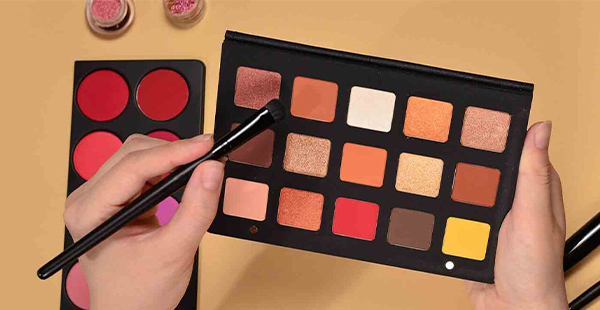Why Is There Asbestos in Makeup?
Some makeup products that include talcum powder may also contain asbestos. Talcum powder is made from talc, a mineral that occurs naturally. Talc and asbestos (another mineral) often form close together in the ground. When companies mine talc for cosmetics, they may accidentally mine asbestos fibers along with it. When this happens, asbestos can contaminate any products made from the talc.
Asbestos in Makeup History at a Glance
- Contaminated Ingredient Names: Baby powder, body powder, cosmetic talc, magnesium silicate, talc, talc powder, talcum powder
- Currently Used? Yes
- Places Used: Blush, bronzer, contour palettes, eyeshadow, face powder, powder foundation
- Asbestos Use Banned: No
- Noteworthy Brands: Avon, Chanel, Claire’s®, Johnson & Johnson (J&J)
Talc is a common ingredient used in makeup. It is often used in powder-based products, such as eyeshadows, blush and powder foundation. Companies put talc in makeup for a variety of reasons. Among them, talc can help absorb moisture and smooth or soften cosmetics for a better feel.
Dangers of Asbestos in Makeup
Asbestos-contaminated makeup poses serious risks. Asbestos can cause diseases like mesothelioma cancer and asbestosis. People who use asbestos-tainted makeup may develop these serious illnesses.
Data indicates these risks stem from the asbestos, not the talc. But users may be unaware of these risks and likely don’t know if the cosmetics they use are tainted with asbestos.
In one study, researchers tested 20 talc products. These included body powders, baby powders, facial talcums and pharmaceutical talc. Half of these products contained at least one type of asbestos. Some of the products contained up to 14% asbestos by weight.
Several recent batches of testing have found asbestos in consumer products. These findings have increased public awareness and spurred lawsuits. But cosmetic talc regulations are still weak, meaning consumers are still at risk of exposure from contaminated cosmetics.
List of Makeup Products Containing Asbestos
Claims of asbestos in makeup have prompted ongoing investigations. The U.S. Food and Drug Administration (FDA) and private groups routinely test cosmetics for asbestos. For example, the FDA has tested beauty products sold at Claire’s and Justice.
Makeup products confirmed to contain asbestos include:
Other makeup products may have asbestos in them. The FDA tries to monitor them but might not catch every contaminated cosmetic. When regulators find asbestos, the test results and product names are usually released on the FDA website.
A variety of companies have sold asbestos-contaminated cosmetic products. Many of these brands are household names. Several are also marketed directly to children.
Asbestos in Children’s Makeup Products
In recent years, asbestos has been found in children’s makeup sold by companies like Claire’s and Justice. These products may put kids at risk of developing serious illnesses.
In 2015, asbestos was found in crime scene investigation toys and crayons. This was one of the first major asbestos-related events involving children’s products.
Current regulations do not require testing for every talc product. Without testing, other contaminated products could be marketed to children.
Retailers often have contracts with specific suppliers to create their makeup products. Despite the well-known dangers of asbestos, suppliers continue to deliver contaminated talc. This includes suppliers in the United States and overseas.
Parents may want to cut out talc products entirely just to be on the safe side.
Who Is at Risk of Asbestos Exposure From Makeup?
Asbestos-contaminated makeup puts anyone who uses it at risk of exposure and illness. This includes both adults and children. People who mine the talc used in cosmetics are also at risk of asbestos exposure.
Exposure can happen at work, home and school. When it happens from asbestos-contaminated makeup, it is considered a non-occupational exposure. This type of exposure is a common cause of mesothelioma in women. Any level of asbestos exposure can cause diseases, like lung cancer or mesothelioma.
Asbestos Lawsuits, Settlements & Other Compensation
Anyone who develops an asbestos-related disease from contaminated talc may qualify for compensation. This compensation can come in different forms. Lawsuit verdicts and settlement agreements may provide compensation for injuries. It may also come from asbestos trust funds.
Some successful mesothelioma lawsuits stemming from asbestos in makeup include:
- In 2022, a California jury ordered Avon to pay $50 million. The plaintiff was a 76-year-old woman who developed mesothelioma. She had some Avon products that tested high in asbestos content.
- In 2020, a New York jury reached a verdict in favor of a man and woman in a mesothelioma case. The verdict required Johnson & Johnson to pay $120 million. The woman blamed her cancer on the company’s asbestos-tainted baby powder.
- In 2016, a Missouri jury awarded $72 million to the family of a 62-year-old ovarian cancer victim. The woman had used Johnson & Johnson talc products for over 35 years.
Successful mesothelioma lawsuits can serve many purposes, including:
- Assisting with medical costs
- Covering lost wages
- Holding asbestos companies responsible
Asbestos victims can contact an asbestos law firm to file a lawsuit. Experienced lawyers understand asbestos laws and know how to build successful cases.
Safety Precautions for Asbestos Cosmetics
People can take steps to protect themselves and children from asbestos in cosmetics. Adults may want to avoid purchasing talc-based products for themselves or for children.
You can read the label to see if a product contains talc. You may also want to watch for recalls. The FDA and the Environmental Working Group (EWG) occasionally announce recalls and warnings when concerns about consumer products arise.
What Are Asbestos-Free Cosmetics?
Some products are talc-free and more likely to be asbestos-free. Companies have switched to talc substitutes to lessen the possibility of asbestos contamination. These products may have labels advertising them as talc-free. Consumers can buy talc-free makeup to reduce the risk of using asbestos-contaminated products.
Cosmetic brands that offer talc-free products include:
- Affordable Mineral Makeup
- bareMinerals®
- Burt’s Bees®
- Ecco Bella
- Everyday Minerals
- Honest® Beauty
- ILIA Beauty
- IT Cosmetics™
- jane iredale®
- Juice Beauty
- Milk Makeup
- Omiana®
- Pacifica®
- PÜR Cosmetics
- SheaMoisture®
- Smashbox™
- theBalm Cosmetics
- W3LL PEOPLE
Who Is Responsible for Cosmetic Safety?
The FDA regulates the cosmetics industry, including talc makeup products. But the agency has very little power over cosmetic companies. The agency cannot recall products. Instead, it encourages the companies that make them to voluntarily recall harmful goods.
The FDA monitors cosmetics for asbestos contamination. Sometimes the agency begins research after consumers or independent groups express concerns about a product. The agency recently began testing talc products more routinely.
Consumers should keep in mind that cosmetic companies are not required to test the safety of their products or present a list of ingredients to the FDA.
Asbestos is not banned in this country. But consumers can tell their legislators they support a full ban. Over time, public pressure may lead to better asbestos and cosmetics regulations.







